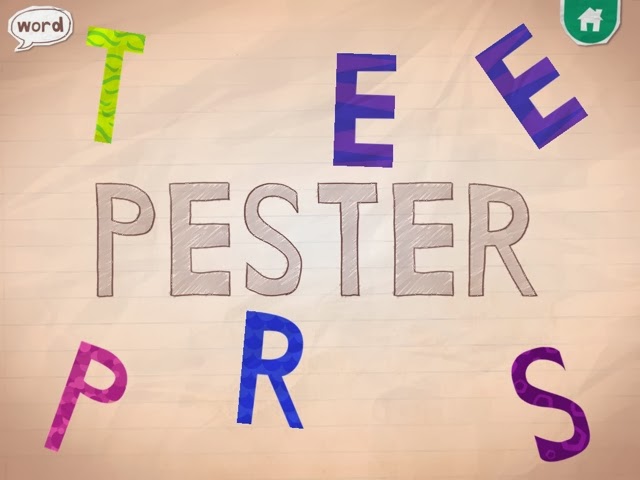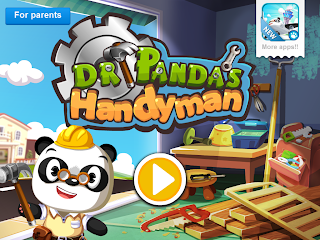My preschooler was home sick today, so
I decided to finally bite the bullet and buy the Monsters, Inc.Storybook Deluxe
by Disney. And I have to grudgingly admit that it's not a terrible ebook.
Understand that this is faint praise. I bought the app because the poor girl
was on the couch, moaning and groaning, and I expected this to be a half-hour
distraction (and that it happily was!) But I've written elsewhere about how
dubious I was that an app with this iTunes description could actually be much
of a literacy experience:
Description
***Unlock content for the Monsters
University Storybook Deluxe app!
***Relive the incredible story of the highly acclaimed film classic Disney•Pixar
Monsters, Inc.
***Find hidden Scare cards throughout the story!
***Fun Game: Navigate your way through a Monsters, Incorporated scare simulator
training room to collect scream energy!
***Surprisingly fun personalized features, based on your own screaming and
roaring abilities!
FEATURES:
•Retelling of the film Disney•Pixar Monsters, Inc. with read-along text and
full narration!
•Hear quotes from the actual film as you tap on your favorite characters!
•Look for clues to find and collect Scare cards that include pictures of your
favorite monster Scarers, along with their scaring stats!
•Includes short animated clips from the original film!
I'm no Luddite (could a Luddite keep
this blog?), but my head implodes at the thought of a future in which children
chose which "book" to read based on the movie clips included and/or
how loudly they're encouraged to scream at the screen. That said, Brooklyn
cared about none of this. She can't yet read, so she wasn’t seduced by the
marketing materials on iTunes. She was interested in purchasing the app because
she likes the movie—we both do. The writing in the original movie is clever,
and the characters are really fun. I only hoped that some of their personality
would come through in this “storybook deluxe.”
The first thing that happens when you
open the app is an introduction that explains Monstropolis is a city powered by
human screams; “monsters everywhere depend on you!” You’re encouraged to scream
in order to unlock the fun and games. At this, Brooklyn screamed half-heartedly
(but let’s allow that this might be more fun for a kid without a fever; I kind
of wanted to scream myself). Once unlocked, the choices are to READ or PLAY.
The READ option is the ebook. And this is where Brooklyn spent quite a while
listening to the story attentively, with the text-highlighting on. Once the
story had finished, she went back to the home screen and tried the PLAY option,
which was a game in which you tilt the iPad back and forth to maneuver Sully
through a child’s bedroom without touching any of the child’s things (because,
you know, contamination) and then roar as loudly as possible at the child
simulator. This only proved mildly fun, mostly because the technology doesn’t
quite work as well as we wanted it too; neither one of us was able to avoid the
obstacles with much finesse. Later in the evening, when my two-year-old got
home, Brooklyn was eager to share the app with her sister, but it was the
storybook, not the games, she wanted to show her.

So I said up top that this isn’t a
terrible ebook. But that doesn’t mean that it’s quality children’s literature
either. What’s the difference, you ask? Well, it’s not always easy to identify
either one. But here is what I look for in a quality print book… strong
writing, interesting language, subject matter that draws the child in, and
developmentally appropriate themes. Strong writing means the traits that
we teach: things like an identifiable voice (think Olivia), sentence fluency so that it trips off the tongue when you
read it out loud (Dr. Seuss), and well-developed ideas (the Harry Potter
series). Interesting language means using just the right word at just the right
time. The best children’s books introduce interesting words effortlessly, so
that the children are not endlessly asking, “What does that mean, again?” It
doesn’t mean always using a fancy synonym… But what would Where the Wild Things Are be without the “wild rumpus”? And, of
course, even if the writing and language is strong, the book has to speak the
children: it has to be about something they care about.
In this case, the monsters (as they
were created for the screen) are funny and loveable characters who are engaged
in an elemental fear of all children: scaring them in the dark. What could be
better? Lots, it turns out. This ebook is a straight synopsis of the movie. The
writers try to encapsulate everything from the 95 min movie into a 35-page
book. It barely makes sense even if you've seen the movie; it is nowhere near
as funny or as clever as the movie. Worst of all, the characters have none of
the personality, and Brooklyn could barely keep the plot straight (on one of
the first pages the Child Detection Agency is introduced and the acronym CDA
first used; later they are referred to only as the CDA and Brooklyn asked me “What’s
that mean, again?”) In general, a good rule of thumb when looking for quality
children’s literature is to stay away from movie tie-ins. There are exceptions,
of course… Shrek, for example, began as an excellent book, before it was an
excellent movie. But this is a disappointment in terms of literature. In terms
of entertainment, well, Brooklyn looked happy enough.
Part of what might have entertained her
are the positive digital features to this ebook. In my opinion, what Disney did
really well in developing this interactive storybook is in the development of
the ebook itself. The term “ebook” can really mean anything these days, from a
PDF of the printed book, to essentially a cartoon. Minimally, I think an
interactive storybook that I download from iTunes has to have illustrations on
a screen with an oral reading of the text and some hotspots to click on here
and there. Animations, zooming in and out, musical scores, sound effects, text
highlighting, built-in dictionaries, hotspots where the reader clicks to
interact with a character or object, foreign language translations, voice
recognition, tilting and shaking of the physical machine, built-in games and
the option to record my own voice can all be nice additions. Or they can be
distractions, depending on the design of the app and the reader. Good
ebooks need to manage all of these digital features in a fashion that is
workable for developing readers. That is, the kids need to be able to focus on
the text, first and foremost. And the digital features need to support the
story.

The Monsters Inc. Storybook Deluxe
actually does this really well. The text is off-set from the illustrations and
highlighted word-by-word as it is read, so that the child is looking solely at
the text for as long as it is read, and then can swipe to see the full
illustration. Once the text has been read, flashing symbols indicate where the
hotspots are that uncover new parts of the illustration, supporting the child’s
comprehension. Although Brooklyn enjoyed the professional narration, including
some of the actors from the movie, another nice extra that is available is that
there is an option to record your own voice reading the text. Older children
might benefit from the fluency practice of recording themselves and listening
to their own playback. With such a long storybook, I also personally enjoyed
the dropdown menu at the top that allowed us to choose any page to jump to at
any time. And best of all was the separation of the READ and PLAY features.
There was no need to scream or roar at anyone while reading the ebook.
While I wish the book itself was better
(and at $6.99 I can’t really recommend the app to anyone), I can say that
Disney has some pretty smart app designers on board. I just hope they come up
with some more interesting projects in the future.










































